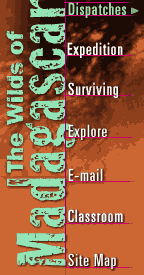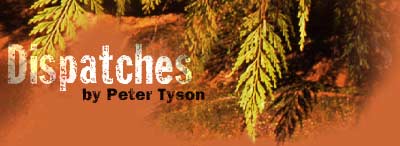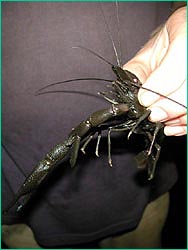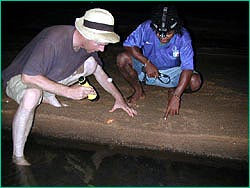
|
 |
 May 26, 2000 Croc Cave
It all began earlier in the morning, when Martin Smith, the cinematographer who for a year has been filming Madagascar's crocodiles for the upcoming NOVA film on the Ankarana, offered to lead me upriver into the crocodile cave. We were accompanied by Josephson Mananandry, a muscled, moustachioed Malagasy of the Antandroy tribe who has been assisting Smith. As soon as we arrived at the entrance to the cave, Smith, a tall, companionable Englishman sporting a week's stubble, began priming me with warnings learned from a year in the field. "Try not to step on the leaves," he said as we tromped along the leaf-strewn riverbank in our bare feet. (Shoes would be an encumbrance in the sticky mud of the underground river.) "You may just find a scorpion there."
Shortly after entering the cave, which resembled the broad maw of a catfish, he answered my question about whether local tales of 20-foot crocs were true in the affirmative. He himself had seen crocodiles well over 15 feet long. As if to bring home the point, he shined his headlamp on a large crocodile footprint in the sand. It bore disconcertingly clear claw marks. "Big one" is all he said. Holding his flashlight low to the ground to bring out the shadows, he began finding dozens of croc tracks. Each bore a parallel path of those clawed footprints bisected by a straight line: the imprint of the tail. The tracks led further into the cave, either along the cave walls or into the many pools of cloudy water left behind as the river lowered in the hours after a downpour had given it rise. I couldn't help but notice how fresh the tracks appeared. They looked as if they had been made minutes before. The sand in which many of them lay was still wet from the formerly heightened river, so clearly they couldn't be more than hours old. Yet I felt remarkably calm. The cave was as wide as a four-lane highway and had huge ridges of dry sand presumably unappealing to crocodiles. And my two companions were veterans who had been coming into the cave for a year.
So sanguine was I that I felt disappointed when Smith suggested we turn back after only half a mile or so. He felt insecure venturing further into the many-passaged cave without a guide. Once, with Angeluc Razafimanantsoa, he had gotten lost and had had to sit in the dark for an hour while Angeluc searched for the way out. Unwilling to return so soon, I asked Smith if he would mind if I went ahead just a little way by myself, to get the feel of being alone in the crocodile caves. He said sure, no problem—a little too quickly, I thought. But I was feeling good and immediately struck off upstream, wading up to my calves in the softly flowing water. It wasn't until I got up around a bend and was out of sight of the others that I began to feel slightly anxious. What if I should spook a croc lying on that bank above me, I thought? Would he head straight for the water, or would he stop to take my leg off? I heard a half-hoot, half-gulp sound up ahead. Is that the sound crocodiles make, I wondered? I shined my light out in the pool to my left. Something long and dark hung in the water. A croc? No, a stick. I walked on, now half confident, half spooked. I saw eyeshine ahead on the sand, and it was raised a few inches off the ground—much higher than those of insects scampering around. Was it a baby croc? If so, was Mom nearby? I wracked my brains: Do mother crocs defend their infants like mother bears? As I stepped closer, I thought, Is Mom just over that lip of sand? Then I thought: Is that eye just one of a pair, the other lying out of sight because the animal is turned perpendicular to my path? The eyeshine, it transpired, belonged to a frog, a discovery that restored enough of my waning bravado to convince me to switch off my headlamp. Under normal circumstances, I like to savor the oppressive blanket of pure cave darkness.
I switched on my headlamp. It had been but half a minute or so, but my adrenalin had begun pumping so furiously that it felt much longer. Now I was really spooked. I turned and quick-stepped back the way I had come, my bare soles picking up a skein of mud from the riverbank. A cloud of bugs that had been swarming my headlamp since we first came in couldn't quite keep up with my new pace and ended up in my mouth, nose, and eyes. Now and then a foot would go out from underneath me on the slick bank. I trained my light on every dark object in the water, whipped my head around to get a better fix on every sound. When I finally rounded a bend and made out two white circles of light, my relief was palpable. Now, as I sip a beer back in camp, my loss of confidence in the crocodile cave seems almost ludicrous. On the way out, we saw eyeshine across a pool, and all I wanted to do was go closer. And later in the day, we saw three large crocodiles on the river several miles downstream from the cave, and they were so skittish that they fled when we were still 100 yards away. (Their skittishness may be an evolutionary adaptation that has helped them survive for many millions of years.) All I can say is, if you think my behavior ludicrous, try turning off your headlamp half a mile deep and alone in a cavern system bearing the world's only cave-living crocodiles. We'll see who laughs last. Peter Tyson is Online Producer for NOVA. Tomorrow we will begin making our way to the Marojejy Reserve, site of the second half of this NOVA/PBS Online Adventure (see The Mission). Dispatches Forest of Hope (June 7, 2000) A Great Day for Silkies (June 4, 2000) Camp Life Unveiled (June 3, 2000) Three Hours with the Silkies (June 1, 2000) Angels of Marojejy (May 31, 2000) Wildlife (May 30, 2000) Into the Marojejy Massif (May 28, 2000) Croc Cave (May 26, 2000) Fossa! (May 25, 2000) Bat Cave (May 24, 2000) Update: English Camp (May 23, 2000) Update: Sunken Forest (May 21, 2000) Update: Night Walk (May 20, 2000) Update: 70 Feet Up (May 19, 2000) Update: Tropical Downpour (May 18, 2000) Photos: (1-4) Peter Tyson. The Expedition | Surviving The Wilds | Explore Madagascar Dispatches | Classroom Resources | E-Mail | Resources Site Map | The Wilds of Madagascar Home Editor's Picks | Previous Sites | Join Us/E-mail | TV/Web Schedule About NOVA | Teachers | Site Map | Shop | Jobs | Search | To print PBS Online | NOVA Online | WGBH © | Updated November 2000 |
 Martin Smith (left) and Josephson Mananandry stand
before the entrance to the crocodile cave.
Martin Smith (left) and Josephson Mananandry stand
before the entrance to the crocodile cave.
 The great broad maw of the cavern entrance opened
before us as we entered the crocodile cave.
The great broad maw of the cavern entrance opened
before us as we entered the crocodile cave.
 Martin Smith says this is the largest crawfish he has
seen in a year of working in the caves.
Martin Smith says this is the largest crawfish he has
seen in a year of working in the caves.
 Smith and Mananandry measure a fresh croc track on
the bank of the underground river.
Smith and Mananandry measure a fresh croc track on
the bank of the underground river.